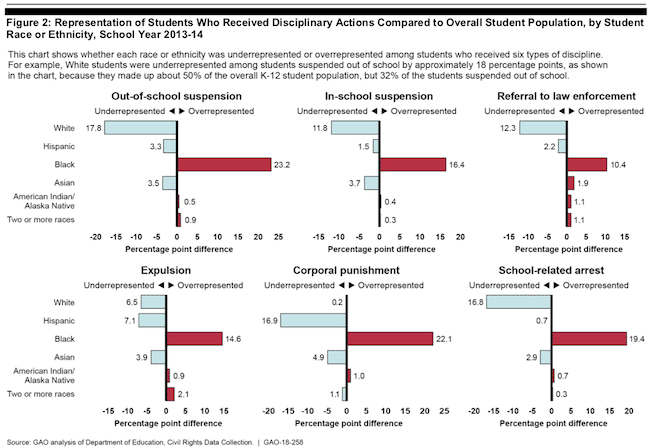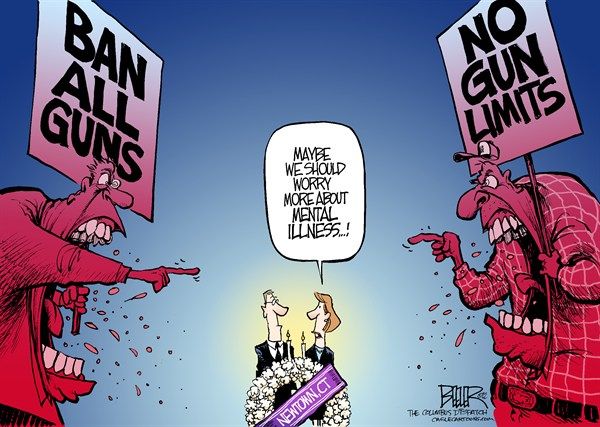Over 75% of Mass Attackers Communicate Prior to Their Attacks
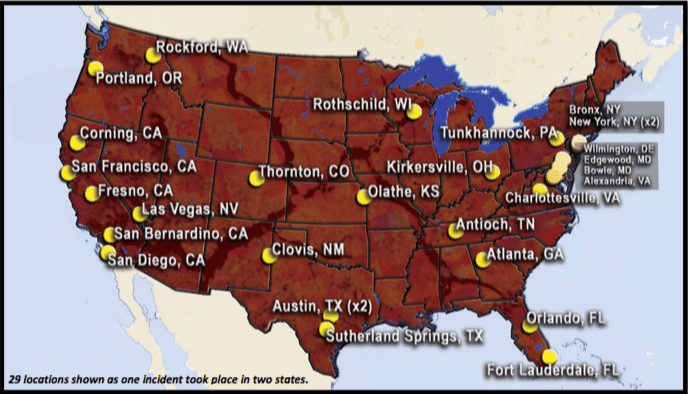
In what I view as further support for state and Federal “Red Flag” legislation allowing law enforcement to seek an “Extreme Risk Protection Order” sometimes referred to as a “Gun Violence Restraining Order”, a report released today from the National Threat Assessment Center (NTAC), part of the United States Secret Service, sheds new light on mass attacks carried out in public places. The NTAC studied 28 incidents that were carried out at 31 sites in 2017 (see map).
Highlights from the report include:
- Over three-quarters (79%) made concerning communications and/or elicited concern from others prior to carrying out their attacks. On average, those who did elicit concern caused more harm than those who did not.
- Nearly half were motivated by a personal grievance related to a workplace, domestic, or other issue[s].
- Over half had histories of criminal charges, mental health symptoms, and/or illicit substance use or abuse.
- Nearly two-thirds of the attackers experienced mental health symptoms prior to their attacks. The most common symptoms observed were related to psychosis (e.g., paranoia, hallucinations, or delusions) and suicidal thoughts.
- All had at least one significant stressor within the last five years, and over half had indications of financial instability in that timeframe.
The key findings from the report, “support existing best practices that the U.S. Secret Service has established in the field of threat assessment. They highlight the importance of gathering information on a person’s background, behaviors, and situational factors; corroborating the information from multiple sources; assessing the risk the individual poses for violence; and identifying intervention points to mitigate that risk. I’ve been discussing these intervention points with members of the NTAC to better understand what we can do to protect our children from threats at school.
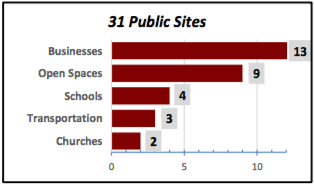
I’ve been a proponent of the #WalkUp movement as a way to both change the culture in our schools, but more importantly as a means to protect our kids in school. After discussing the efficacy of #WalkUp with members of the NTAC a couple of things stand out. One, if done early enough, the principles espoused by #WalkUp can be an effective way to change the path of isolated and disaffected youth. That is not to say that we are asking children Two, at some point these attackers move beyond what might be done by friends, teachers, coaches. They move into the realm of mental health professionals and law enforcement.
With regards to the impact that #WalkUp can have in preventing these mass attacks, the report indicates that 79% of the attackers “engaged in communications or exhibited behaviors that caused concern in others. Those who expressed concern included parents, siblings, current or former romantic partners, friends, neighbors, teachers, classmates, work associates, community members, and law enforcement” (emphasis added).
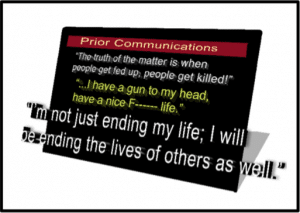
The importance of acting on this information is emphasized once again in this report, “The responses to the behaviors varied amongst those who noted them. Some acted on their concerns by warning others about the person, filing complaints with employers or residential building managers, or deliberately avoiding the person altogether. Others expressed concern by notifying law enforcement, pursuing protective orders, or terminating the attacker’s employment. Some of those concerned spoke to the person directly and urged them to seek help, offered help, or even secured psychological evaluations for them.” We’ve seen the tragic consequences when these threats are not taken seriously by authorities.
With regards to the role that mental health plays in the lives of the attackers. All of the attackers had at least one significant stressor occur in their lives in the five years leading up to the attack. For some, this was in addition to any legal consequences they may have been dealing with related to the charges described above. These additional stressors most often related to:
- Family/romantic relationships, such as spousal estrangements, divorces, romantic breakups, rejected proposals, physical or emotional abuse, or the death of a parent
- Personal issues, such as unstable living conditions, physical illnesses, or other significant disorders
- Work or school environments, such as being fired or suspended, filing grievances, being bullied at work or at school, feeling disrespected, or being the subject of real or perceived gossip
- Contact with law enforcement that did not result in arrests or charges, such as being the subject of domestic disturbance calls or being sought for a crime unrelated to their attack
As the US Congress continues to deliberate on the passage of Federal Red Flag laws, please contact your Representative and Senators and encourage them to support legislation proposed by Senators Reed, Rubio & Nelson. Here is what the Red Flag legislation proposes.
The Extreme Risk Protection Order and Violence Prevention Act:
- Creates an Extreme Risk Protection Order Grant Program at the U.S. Department of Justice.
- Makes states enacting qualifying laws eligible for funding to help implement such laws, as well as priority consideration for Bureau of Justice Assistance discretionary grants.
- Requires that a qualifying state law be in compliance with the minimum requirements described in the act, including: Providing a process where a law enforcement officer or family member of an individual can petition for – and after notice and hearing a court can grant – an Extreme Risk Protection Order if the court finds by clear and convincing evidence that such individual poses a significant danger of causing personal injury to himself or herself or others by possessing or purchasing a firearm.
- The duration of such order may not exceed 12 months but may be renewed upon a showing of clear and convincing evidence it remains warranted.
- Respondent has the right to request a hearing to vacate an order or renewal.
- Providing a process where a Temporary Ex Parte Extreme Risk Protection Order can be issued if a court finds probable cause to believe that an individual poses a significant danger of causing personal injury to himself or herself or others in the near future by possessing or purchasing a firearm.
- Establishing a felony criminal offense for knowingly making a false statement relating to an Extreme Risk Protection Order regarding a material matter.
- Requiring clear processes and instructions for the surrender of a respondent’s firearms should an Extreme Risk Protection Order be issued, as well as clear processes and instructions for the swift return of such firearms upon expiration or successful motion to vacate an order.
Requiring that an issuance of an Extreme Risk Protection Order be reported to the appropriate federal, state, and tribal databases.

